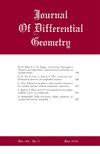用拓扑同位素法创建斯坦因表面
IF 1.3
1区 数学
Q1 MATHEMATICS
引用次数: 2
摘要
我们将Freedman拓扑与Eliashberg全纯理论结合,构造了复杂曲面上的Stein邻域系统,并利用这些邻域系统研究了凸性和凹性的各种概念。在C^0$-小拓扑环境同位素之后,在复杂表面上的每一个温顺的拓扑嵌入$2$-复杂$K$,都是不可数嵌套的Stein正则邻域族的交集,这些邻域都是拓扑环境同位素相关的$K$,但经常实现不可数的许多差分同构类型。它们来自于拓扑映射柱面的康托集水平。邻域的边界是$3$-流形,仅在拓扑上嵌入,但仍然满足伪凸性的概念。这样的$3$流形具有超曲面的一些基本性质,这些性质在通常的光滑意义上是严格的伪凸,但它们更为常见。利用同胚于$\mathbb{R}^4$的无数个微分同胚类型实现了拓扑伪凸性的互补概念。本文章由计算机程序翻译,如有差异,请以英文原文为准。
Creating Stein surfaces by topological isotopy
We combine Freedman’s topology with Eliashberg’s holomorphic theory to construct Stein neighborhood systems in complex surfaces, and use these to study various notions of convexity and concavity. Every tame, topologically embedded $2$-complex $K$ in a complex surface, after $C^0$-small topological ambient isotopy, is the intersection of an uncountable nested family of Stein regular neighborhoods that are all topologically ambiently isotopic rel $K$, but frequently realize uncountably many diffeomorphism types. These arise from the Cantor set levels of a topological mapping cylinder. The boundaries of the neighborhoods are $3$-manifolds that are only topologically embedded, but still satisfy a notion of pseudoconvexity. Such $3$-manifolds share some basic properties of hypersurfaces that are strictly pseudoconvex in the usual smooth sense, but they are far more common. The complementary notion of topological pseudoconcavity is realized by uncountably many diffeomorphism types homeomorphic to $\mathbb{R}^4$.
求助全文
通过发布文献求助,成功后即可免费获取论文全文。
去求助
来源期刊
CiteScore
3.40
自引率
0.00%
发文量
24
审稿时长
>12 weeks
期刊介绍:
Publishes the latest research in differential geometry and related areas of differential equations, mathematical physics, algebraic geometry, and geometric topology.

 求助内容:
求助内容: 应助结果提醒方式:
应助结果提醒方式:


